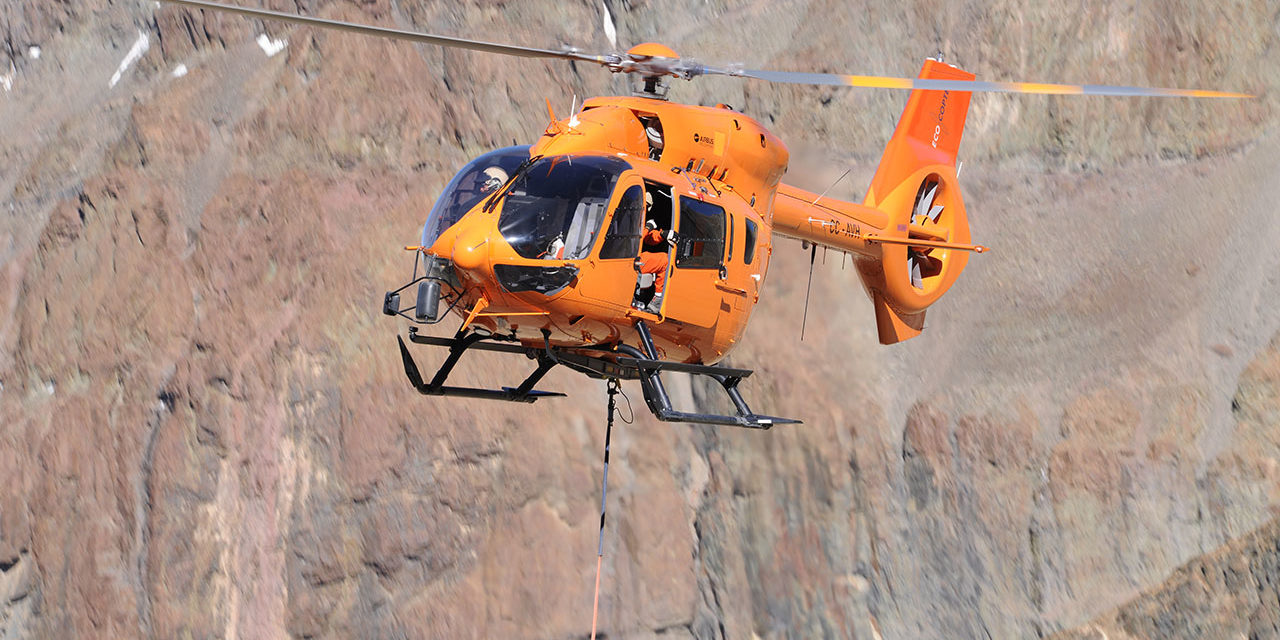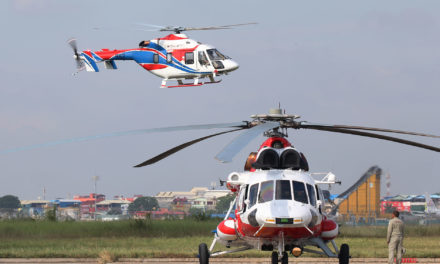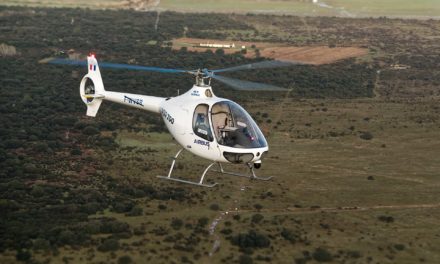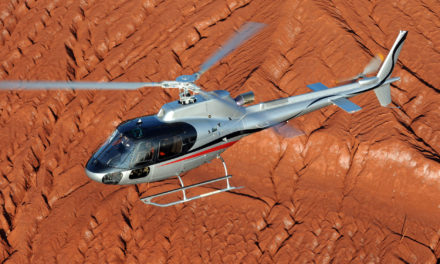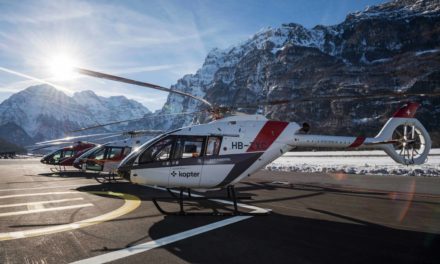Nested in a corner of La Reina airfield, in the Eastern suburb of Santiago de Chile, EcoCopter has carved itself a special position in the Andean skies. Its colourful helicopters crisscross the skies all over the country to complete a wide range of works but it is without doubts the Paris-Dakar race that tossed it under the spotlights as early as 2009.
EcoCopter was born in 2003 with the clear ambition to lead the Chilean aerial works market with a small fleet of versatile AS 350 Ecureuil helicopters, perfectly suited for high altitude operations. The team has been looking for innovation right from the outset but safety is prime when it comes to mountain flying, if only to reassure their customers. They chose the B3 variant to be their workhorse in the Andean ranges for mining aerial support, passenger transportation (including off-shore) and many other on-demand services. It took barely six years for EcoCopter to reach a respectable size which paved the way to two new playgrounds: a new subsidiary in Peru and support of the Paris-Dakar car rally that moved to South America for security reasons.
An exceptional operation
Launched in 1977 by Thierry Sabine, the celebrated race has always been avid for helicopters, the perfect tool to follow the competitors in the open desert and provide formidable pictures to a global audience. Little has changed since then, the faithful Ecureuils are still in attendance and since 2009, the whole operation has been covered by EcoCopter. The company was selected upon very simple criteria, explains Francisco Diaz, COO and pilot with EcoCopter: “It was the first rally in South America, we were selected as the main helicopter provider because EcoCopter was the only helicopter company in Chile or Argentina that could provide the eight helicopters requested by ASO. Now we´re celebrating our 10th Dakar edition, with more than 5,000 hours flown in total since its inception”
The requirements were important from the outset and the company had to face a real organisational challenge. The accumulated experience eventually simplifies the preparation from one year to the next, but it remains a very important moment and the entire team must mobilise several weeks before the kick-off of the race from Buenos Aires, continues Francisco: “The planning of the rally starts two months in advance, with the general information of the routes to be flown, type of terrain, altitudes, fuel needs, distances to be flown, etc.. With these information, we prepare an Operational Briefing with the crews involved in the rally a fortnight before kick-off, where we brief the routes and refueling points in details. We do a risk assessment for each leg and we assign the crews for each day.”
A tight roll-out
The range of missions is wide as the Ecureuils are tasked with aerial shooting (still and moving pictures), the race Director shuttling, race security and various passengers’ ferrying. The eight helicopters provided by EcoCopter are operated by a team of sixteen pilots (including the operations manager who is also a pilot) and eight mechanics. Such an organisation is, by all means, a huge logistical challenge and the airborne part must adhere to its specific requirements, such as regulations committing the company to meet all the legal requirements: “We have two-pilots crews assigned to each machine in order to achieve the maximum flight time, based on duty and rest periods established by the Chilean Aeronautic Authority DGAC,” adds Francisco, “as daylight in the southern hemisphere is long during January, we have to plan this in advance in order to maintain safety and meet the operational requirements from the rally organization. During the rally, a daily briefing is held by the crews and organisation personnel involved in the next day mission. We review the track of the race, GPS waypoints, refuelling points, dangers in the track, radio frequencies, weather forecast, etc…” Taking part in such a global event is a fantastic “business card” for the EcoCopter team who displays a contagious excitement in their daily job working for this outstanding operator.
The constant search for innovation and the high safety standards required from the staff make them feel strongly committed in their response to their customers’ demands. That small team of highly dedicated professionals has developed a true team spirit that transpires in the way they do things, a great benefit for the patrons. One example of this “EcoCopter” spirit is the various colourful liveries painted on the Ecureuils, a trend that starts to be imitated by other helicopter operators throughout the world.
Unique colours
The original idea to adorn helicopters with individual decorations comes from Chilean entrepreneur Eduardo Ergas, owner of EcoCopter. This creates a unique corporate identity to which the staff is happy to adhere. The subjects are all related to science and they convey the values the company wants to promote. Says Francisco “The paintings on our helicopters are the personal touch of EcoCopter owner, he is very driven by science and innovation, and our paint schemes are all science-related or pay tribute to historical figures who contributed to universal sciences (Biology, mathematics, space, insects, marine life, neurons, Charles Darwin, Leonardo Da Vinci, etc..).”
It is a very new way of promoting sciences during each flight and customers are thrilled by the concept. “EcoCopter is now renowned worldwide thanks to these paintings. I could see last year helicopter companies in other parts of the world putting some art on their helicopter schemes… that’s innovation… flying colors!” smiles Francisco. Ten B3s and H125s bear these special schemes, spreading the company identity all over the continent.
A widening offer
Settled in Peru since 2009, EcoCopter also developed its domestic activities by opening a drone department – EcoDrones – that joined the EcoTraining training department and added to a recent firefighting contract with Erikson. Two S-64 Skycranes, Elvis and Anna, are now stationed in Chile to prevent other fires like those that dramatically hit the country in early 2017. The 2018 big news however was the delivery of the country’s first H145, a new asset to support a growing activities. Delivered at the end of FIDAE 2018, this Fenestron-fitted helicopter impressed the EcoCopter pilots by its performances and flexibility. Francisco believes this addition opens new possibilities for his company: “As the local market grew on helicopter demand, and also in supply, we had to show our clients we were a step ahead and could offer a new type of helicopter, capable to do the same – or even better – the B3 performances. We placed a bet and introduced the H145, not only for passenger ferry, but also for utility flights with a medium-class twin-engine helicopter. So far, the H145 is performing very well in hot and high operations, meeting our customers’ needs in performance and safety standards.”
It is obviously a great satisfaction to confirm the capabilities of the H145 in the high altitudes of the Chilean landscape. However, the B3s are not ready to give way to the newcomer. “EcoCopter has been operating the AS 350B3 since the early days of the company, it’s the helicopter that meets most of the needs in Chile, especially for Hot-and-High operations in the Andes mountain ranges. The B3 has no single-engine utility competitor for the aerial works we do,” concludes Francisco. But the H145 keeps the advantage, being 20% more efficient than the B3 for passenger transportation (time of flight), offering a faster ferry speed and a much bigger lifting capacity over 10,000 feet, even though it is a twin-engine helicopter also yielding a much higher flight/hour price.
Whereas the latest Paris-Dakar ended with another set of records and loads of pictures that will stays in the memories, EcoCopter moved back to its core activities: training and flying in the high mountains of the Andean sierras. Of course, the race involved only the decorated Ecureuils, leaving the plain machines to respond to the regular customers’ requests. This is when the H145 proved to be invaluable, thanks to its better performances and easily making up for the absence of the B3/H125s. The planets seems to be nicely lined up for EcoCopter, as the company is still working on future developments and looking for possible newcomers to fill the skies above the Andes.
© Samuel Prétat – février 2019
Acknowlegment: Gracias Francisco Diaz para su ayuda por este artículo.

